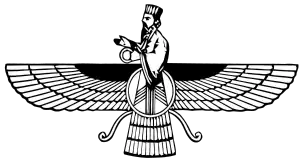Mazdakism
Mazdakism was an Iranian religion, which was an offshoot of Zoroastrianism. The religion has been called one of the most noteworthy examples of pre-modern communism.[1]
| Part of a series on |
| Zoroastrianism |
|---|
 |
|
|
The religion was founded in the early Sasanian Empire by Zardusht, a Zoroastrian mobad who was a contemporary of Mani (d. 274).[2] However, it is named after its most prominent advocate, Mazdak, who was a powerful and controversial figure during the reign of Emperor Kavad I (r. 498–531).[3]
Theology
Mazdakism was a dualistic religion that appeared to be influenced by Manichaeism. It taught that there were two principles, light and dark (good and evil) that merged at a primordial time creating the universe. The Mazdakites worshipped the God of Light.
Ethics
Mazdakism strongly promoted simple and pacifist living. Acts such as murder and killing animals for food or sport were forbidden, as was eating meat. Followers were to treat all people, even their enemies kindly. The movement also believed in the holding of all things in common to reduce greed and, allegedly,[4] promoted group marriage or polyandry, the latter if true presumably due to the lack of women for poor men to marry due to the polygyny of the upper classes of Iranian society at the time.[5]
Citations
- Crone 2012, p. 439.
- Crone 2012, p. 22.
- Daryaee 2014, pp. 26–29.
- Kreyenbroek 2012.
- Yarshater 1983, pp. 999–1000.
Cited sources
- Crone, Patricia (2012). The Nativist Prophets of Early Islamic Iran: Rural Revolt and Local Zoroastrianism. Cambridge University Press. pp. 1–543. ISBN 9781139510769.
- Daryaee, Touraj (2014). Sasanian Persia: The Rise and Fall of an Empire. I.B.Tauris. pp. 1–240. ISBN 978-0857716668.
- Kreyenbroek, Philip G. (2012). "IRAN ix. RELIGIONS IN IRAN (1) Pre-Islamic". Encyclopaedia Iranica. Vol. XIII/4. pp. 432–439. Retrieved 14 December 2021.
- Yarshater, Ehsan (1983). Cambridge history of Iran The Seleucid, Parthian and Sasanian periods. Cambridge. ISBN 978-0-521-24693-4.
General sources
- Boyce, Mary (2001). Zoroastrians: Their Religious Beliefs and Practices. Psychology Press. pp. 1–252. ISBN 9780415239028.
- Eichenberger, L. (2020). "Communist, Heretic, Rebell. Mazdak and the History of Religion". Zeitschrift für Religionswissenschaft. 28 (2): 237–258. doi:10.1515/zfr-2019-0029. S2CID 226223689.
- Frye, R. N. (1983), "Chapter 4", The political history of Iran under the Sasanians, The Cambridge History of Iran, vol. 3, Cambridge University Press, ISBN 978-0-521-20092-9
- Frye, Richard Nelson (1984). The History of Ancient Iran. C.H.Beck. pp. 1–411. ISBN 9783406093975.
